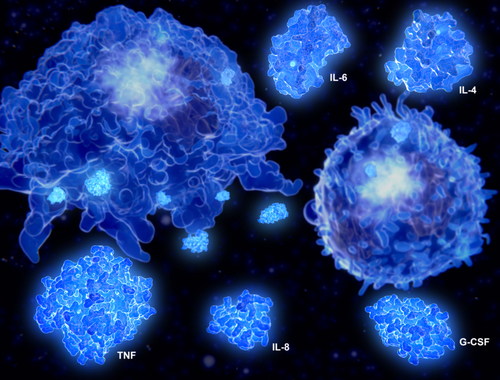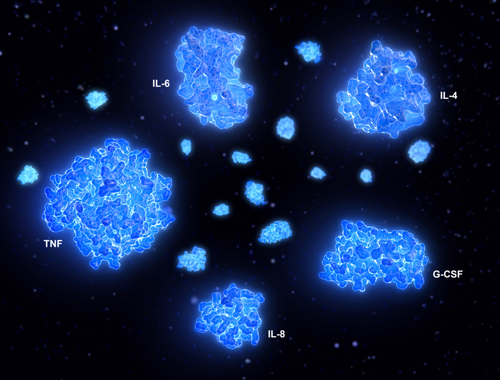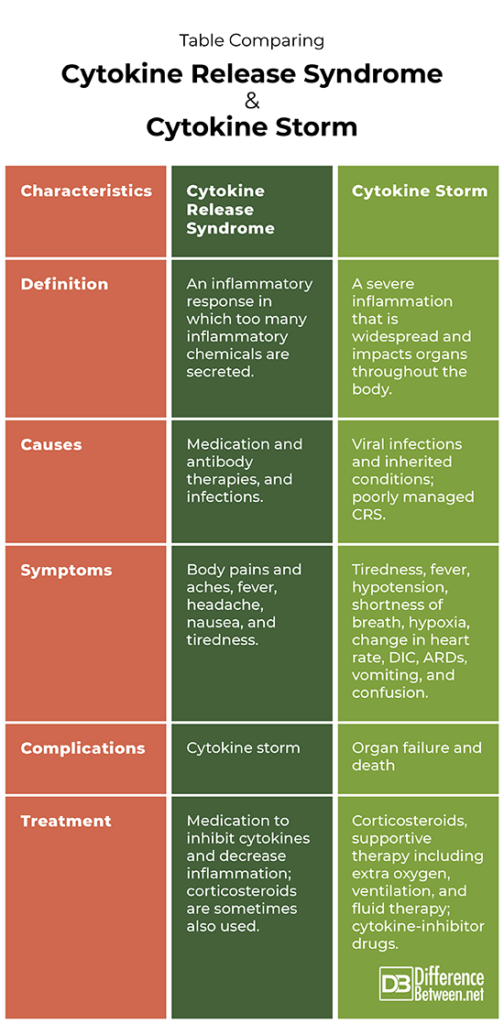Difference Between Cytokine Release Syndrome and Cytokine Storm
Cytokine release syndrome is when a systemic inflammatory response is activated in the body. A cytokine storm is when the systemic inflammatory response is so severe that organ damage becomes possible.

What is Cytokine release syndrome?
Definition:
Cytokine release syndrome (CRS) is a condition in which widespread inflammation occurs in the body in response to certain factors.
Causes:
The cause of CRS is often medication, especially involving antibody-based therapies. However, infections in the body can sometimes also trigger CRS. A CRS is estimated to occur in about 40% of patients who have COVID-19. People with autoimmune disorders like lupus can sometimes get CRS.
Process:
T-cells release the chemicals, tumor necrosis factor and interferon-gamma. These trigger other immune system cells such as macrophages, to release interleukin 6 (IL-6).
Symptoms and complications:
There are several symptoms that can occur if you have CRS. These include fever, rash, body aches and pains due to muscle and joint inflammation. The symptoms can vary from mild to severe. CRS can worsen resulting in a cytokine storm.
Diagnosis:
Diagnosis of CRS is based on a physical exam and noting of the symptoms. Blood tests can also indicate a severe inflammatory reaction.
Treatment:
Medicine to reduce fever and antihistamines are often helpful. In severe cases, fluid therapy and additional supportive measures may be required.

What is a Cytokine storm?
Definition:
A cytokine storm is when there is a dangerous increase in the immune system chemicals in the bloodstream causing high levels of inflammation.
Causes:
A cytokine storm is an extreme inflammatory response that can be caused by inherited conditions such as familial hemophagocytic lymphohistiocytosis (HLH). Infection with viral pathogens such as SARS-CoV-2, influenza A, and Epstein-Barr virus can also result in a cytokine storm. A cytokine storm can occur when CRS worsens.
Process:
In the case of a cytokine storm, the interleukin 6 produced during CRS then activates more T cells leading to a large exaggeration of the immune response.
Symptoms and complications:
A cytokine storm has similar symptoms to a CRS but they are generally worse. A person will feel tired, the fever will increase, there may also be shortness of breath, low blood pressure, changes in heart rate, clotting disorders like DIC (disseminated intravascular coagulation), and acute respiratory distress disorder (ARDs), and mental confusion. Extremities may swell and there may be nausea and vomiting. Untreated a cytokine storm can result in death.
Diagnosis:
Diagnosis of a cytokine storm is based on the symptoms and signs that indicate a person’s worsening condition. A complete blood cell count is also helpful in assessing the level of inflammation and the effects it is having on the body. Biomarkers such as elevated levels of interleukin-6 and liver enzymes can indicate a cytokine storm.
Treatment:
A cytokine storm is a dangerous situation. Supportive therapy including fluid replacement and supplemental oxygen or artificial ventilation may be needed. Medicines such as corticosteroids and cytokine inhibitors can be given. Depending on what organs are affected, cardiac medicines and kidney dialysis may also be required.
Difference between Cytokine release syndrome and Cytokine storm?
Definition
Cytokine release syndrome is when there is an inflammatory response in which too many inflammatory chemicals are secreted. A cytokine storm is when a severe inflammation occurs that is widespread and impacts organs throughout the body.
Causes
Medication, antibody therapies, and infections can cause CRS. Viral infections and inherited conditions, and poorly managed CRS can cause a cytokine storm.
Symptoms
The symptoms of CRS include pains and aches in the body, fever, headache, nausea, and tiredness. The symptoms of a cytokine storm include tiredness, fever, hypotension, shortness of breath, hypoxia, change in heart rate, DIC, ARDs, vomiting, and confusion.
Complications
A cytokine storm is a complication of CRS. Complications of a cytokine storm include organ failure and death.
Treatment
CRS is treated with cytokine-inhibitor medication and corticosteroids. A cytokine storm includes treatment with medications as for CRS but also supportive therapy like extra oxygen and fluid therapy.
Table comparing Cytokine release syndrome and Cytokine storm

Summary of Cytokine release syndrome Vs. Cytokine storm
- Cytokine release syndrome is when there is an inflammatory reaction affecting the body.
- A cytokine storm is when CRS worsens to the point that organs can become badly damaged.
- Both conditions can be treated to some extent with corticosteroids and cytokine inhibitors.
FAQ
What triggers cytokine release syndrome?
Cytokine release syndrome can be caused by certain infections and also by therapies that target the immune system (for example antibody-based therapies).
How do you manage cytokine release syndrome?
Medication that helps regulate the immune system along with supportive therapy can help manage cytokine release syndrome in people who have it.
What happens when too many cytokines are released?
Cytokines are released as a response by the immune system to some perceived threat. Too many cytokines cause an exaggerated response that can begin to drastically affect healthy cells in a negative way.
Is cytokine release syndrome life-threatening?
Cytokine release syndrome can become a life-threatening condition if it is not recognized and treated. It can progress to a cytokine storm, which can lead to organ failure and death.
Is a cytokine storm relevant to COVID-19?
Yes, just under half of all people who contract COVID-19 are likely to develop a cytokine storm. This can be a cause of death in people with coronavirus because it can result in organ failure.
What is a cytokine storm, and does it occur in COVID-19?
A cytokine storm is an extreme immune system reaction in which too many of the immune system chemicals are produced. This does occur in patients who have COVID-19 where it represents a dangerous situation.
- Difference Between Rumination and Regurgitation - June 13, 2024
- Difference Between Pyelectasis and Hydronephrosis - June 4, 2024
- Difference Between Cellulitis and Erysipelas - June 1, 2024
Search DifferenceBetween.net :
Leave a Response
References :
[0]Fajgenbaum, David C., and Carl H. June. "Cytokine storm." New England Journal of Medicine 383.23 (2020): 2255-2273.
[1]Shcherbak, Sergey G., et al. "Basic predictive risk factors for cytokine storms in COVID-19 patients." Frontiers in immunology 12 (2021).
[2]Shimabukuro-Vornhagen, Alexander, et al. "Cytokine release syndrome." Journal for immunotherapy of cancer 6.1 (2018): 1-14.
